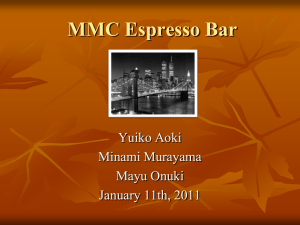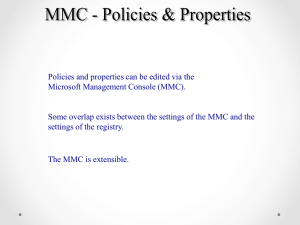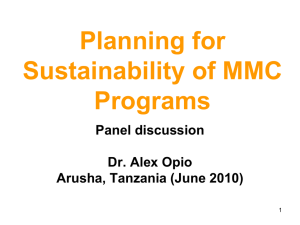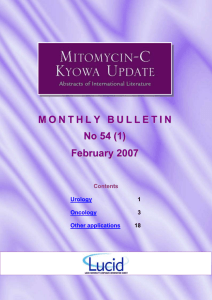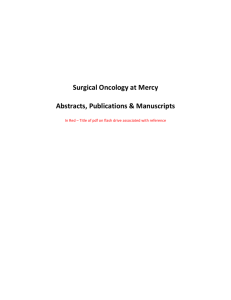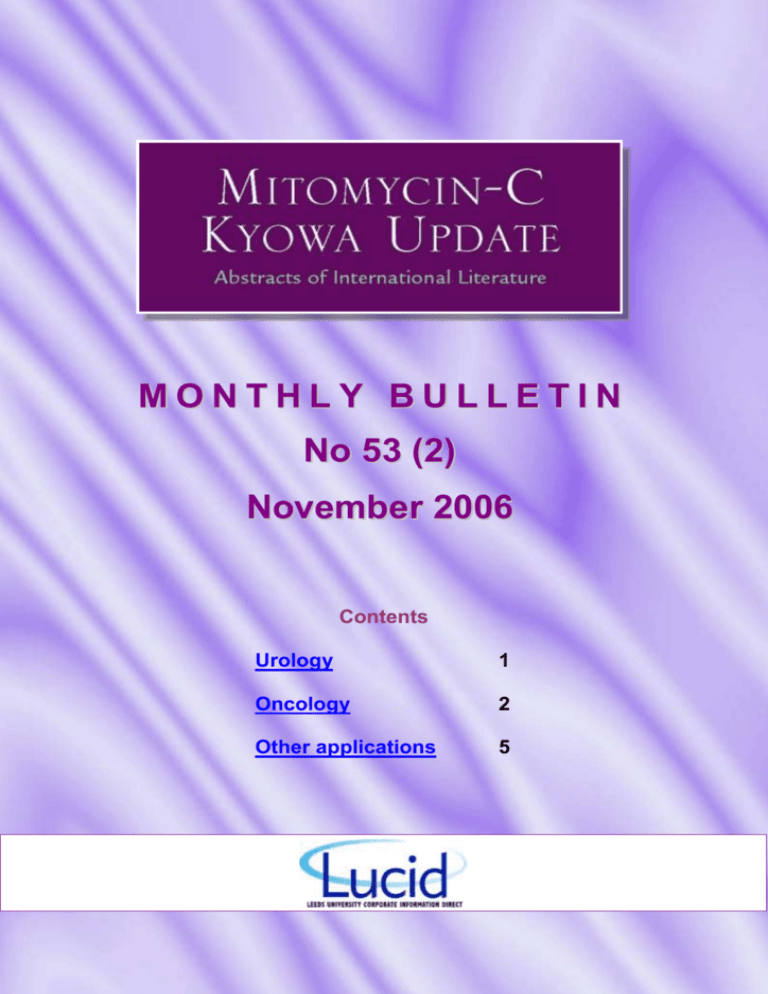
MONTHLY BULLETIN
No 53 (2)
November 2006
Contents
Urology
1
Oncology
2
Other applications
5
Urology
Repeat transurethral resection lowers recurrence rates in T1 bladder tumors, even
after intravesical mitomycin-C
OOSTERLINCK W
Nat Clin Pract Urol 2006;3(11): 582-3*
Local drug delivery to bladder using technology innovations. [Review]##
TYAGI P, TYAGI S, KAUFMAN J, HUANG L, DE MIGUEL F
Urol Clin North Am 2006;33(4): 519-30
Local delivery of drugs directly into the bladder by way of a urethral catheter is a clever
approach to optimize drug delivery to the disease site while reducing systemic bioavailability.
Pharmacotherapy by this route is referred to as intravesical delivery. In recent years,
intravesical delivery has been used in combination with an oral regimen of drugs or as
second-line treatment for neurogenic bladder and detrusor overactivity. Negligible absorption
of instilled drugs into the systemic circulation explains the near-minimal adverse toxicity
reported with this form of therapy. The authors discuss shortcomings of the current options
available for intravesical delivery and provide a broad overview of the latest advances
through technology innovation to overcome these drawbacks.
Oncology
Anal cancer: current and future methodology. [Review]
ENG C
Cancer Invest 2006;24(5): 535-44
Despite the small number of patients affected by carcinoma of the anal canal it remains one
of the most challenging cancers to treat. For although it is one of the few malignancies that
may be cured with chemoradiation alone, the use of combined modality therapy may result in
significant treatment-related morbidity. Novel approaches currently are underway in this
select patient population and will be addressed for the purposes of this manuscript.
A case of effective multidisciplinary treatment with hepatic resection for synchronous
multiple liver metastases from rectal cancer. [Japanese]
HARAGUCHI Y, UENO S, SAKAMOTO F, TOYOYAMA H, IKEDA N, KAMIKADO C, et al.
Gan To Kagaku Ryoho 2006;33(10): 1473-5*
A 56-year-old-man complained of abdominal pain, and was diagnosed as having advanced
rectal cancer with synchronous multiple metastatic liver cancer (H3) in July 1999. He
underwent low anterior resection and hepatic partial resection (S1, S2+S3, S5, S6, S8) in
August 1999. In addition, he underwent hepatic arterial infusion chemotherapy 6 times at
ADM 30 mg + 5-FU 1000 mg + MMC 16 mg between October 1999 and July 2000 for
recurrent metastatic liver cancer. He has survived more than 6 years after the initial surgery.
Multidisciplinary treatment with hepatic resection may well be a strategy for patients with
multiple colorectal liver cancer, even though H3 type of metastasis.
## MMC not specifically mentioned
* Article not held at Leeds University
1
Case report of a liver metastasis from rectal cancer achieving complete response (CR)
by a combination of intra-hepatic arterial infusion of irinotecan (CPT-11) with
degradable starch microspheres (DSM) and weekly high-dose intra-hepatic arterial
chemotherapy with 5-FU. [Japanese]
WATANABE M, TSUCHIYA M, TAKITA W, OTSUKA Y, TAMURA A, YAMAZAKI K, et al.
Gan To Kagaku Ryoho 2006;33(10): 1485-8*
A 67-year-old woman, who was diagnosed with rectal cancer and liver metastasis,
underwent a low anterior resection of the rectum in May 2004. Two months later, the level of
tumor markers increased and a CT scan revealed a 45 x 35 mm liver metastasis in the S8
segment. She was referred to our hospital for treatment of the liver tumor. Intra-hepatic
arterial infusion of irinotecan (CPT-11) and MMC with degradable starch microspheres (DSM)
was given in July 2004. Following this, a 34-week course of weekly high-dose intra-hepatic
arterial 5-FU infusion (5-FU 1000 mg/m2) was performed. In April 2005, the size of the liver
metastasis decreased, and the level of serum tumor marker normalized. A CT and echo
scan revealed a calcified tumor, and therefore all chemotherapy was stopped. She was
followed in the outpatient clinic, with no evidence of recurrence for 12 months. This case
suggests that the use of intra-hepatic arterial infusion of CPT-11 and MMC with DSM is
useful for the treatment of liver metastases in colorectal cancer.
Treatment results of adjuvant chemotherapy after radical hysterectomy for
intermediate- and high-risk stage IB-IIA cervical cancer
TAKESHIMA N, UMAYAHARA K, FUJIWARA K, HIRAI Y, TAKIZAWA K, HASUMI K
Gynecol Oncol 2006;103(2): 618-22
OBJECTIVE: To determine the effectiveness of chemotherapy alone as postoperative
adjuvant therapy for intermediate- and high-risk cervical cancer. METHODS: The study
group comprised 65 consecutive patients with stage IB or IIA squamous cell or
adenosquamous cervical cancer who were initially treated with radical hysterectomy and
pelvic lymphadenectomy between 1993 and 2002. Tumors were of intermediate risk (stromal
invasion >50%, n = 30) or high risk (positive surgical margin, parametrial invasion, and/or
lymph node involvement, n = 35). In all cases, chemotherapy was administered adjuvantly:
three courses of bleomycin, vincristine, mitomycin, and cisplatin for intermediate-risk cases
and five courses for high-risk cases. Disease-free survival and complications of the
combined therapy were investigated. RESULTS: Estimated 5-year disease-free survival was
93.3% for the 30 patients with intermediate-risk tumors (100% for those with squamous cell
carcinoma and 71.4% for those with adenosquamous carcinoma) and 85.7% for the 35
patients with high-risk tumors (89.3% for those with squamous cell carcinoma and 71.4% for
those with adenosquamous carcinoma). The incidence of locoregional recurrence was 3.3%
in the intermediate-risk group and 8.6% in the high-risk group. Side effects of chemotherapy
and complications of the combined therapy were within acceptable limits. No patient had
severe bleomycin-related pulmonary toxicity. Only 1.5% of patients developed small bowel
obstruction, which was cured by conservative therapy. CONCLUSIONS: The treatment
results suggest the potential role of adjuvant chemotherapy alone for patients with cervical
cancer. (C) 2006 Elsevier Inc. All rights reserved.
Capecitabine and mitomycin-C is an effective combination for anthracycline- and
taxane-resistant metastatic breast cancer
## MMC not specifically mentioned
* Article not held at Leeds University
2
MASSACESI C, LA CESA A, MARCUCCI F, PILONE A, ROCCHI MB, ZEPPONI L, et al.
Oncology 2006;70(4): 294-300*
Capecitabine is converted to 5-FU by thymidine phosphorylase, and MMC is capable of
upregulating the expression of thymidine phosphorylase suggesting a synergistic effect. A
group of 53 patients (median age: 62 years) with anthracycline- and taxane-resistant,
metastatic breast cancer received MMC 6 mg/m2 on day 1, and capecitabine (Xeloda) 2000
mg/m2/day from day 1 to day 14 with cycles repeated every 4 weeks. Overall, 77.4% had
visceral metastases and 33 were pretreated with ≥3 chemotherapy lines. A median of 6
cycles were given (range: 1-19) with a complete response observed in 2 patients (3.9%),
partial response in 17 (33.3%) and stable disease in 19 (37.2%). Overall response rate was
37.2% (95% CI, 24.0-50.5%), with a median duration of 10.4 months. Median time to
progression was 8.1 months and median survival was 17.4 months (1- and 2-year survival
rates of 60 and 28%, respectively). Toxicity was mild. The most frequent grade 3/4 events
were neutropenia (5.7% of patients), diarrhea (3.8%), and deep venous thrombosis (3.8%).
Capecitabine plus MMC may represent an effective and manageable treatment option for
advanced breast cancer patients resistant to anthracyclines and taxanes. This approach
provides an alternative for pretreated patients with advanced breast cancer. (C) 2006 S
Karger AG, Basel.
Cytoreductive surgery combined with intraperitoneal chemohyperthermia for the
treatment of advanced colon cancer
ZANON C, BORTOLINI M, CHIAPPINO I, SIMONE P, BRUNO F, GAGLIA P, et al.
World J Surg 2006;30(11): 2025-32
BACKGROUND: Chemohyperthermic peritoneal perfusion (CHPP) after extensive
cytoreductive surgery is a possible choice as a regional treatment for peritoneal
carcinomatosis (PC). The multicentric France EVOCAPE 1 study demonstrated that the
median overall survival of patients with colon peritoneal carcinomatosis subjected to
conventional surgical and/or chemotherapeutic treatment was 5.2 months. Historically, MMC
is the drug of choice in the treatment of intraperitoneal carcinomatosis from colon cancer.
METHODS: 25 patients affected by stage IV colon cancer with only peritoneal involvement
and a prior completion of at least a partial first cycle of systemic chemotherapeutic and/or
surgical treatment (24 patients) were enrolled. Immediately following extensive cytoreductive
surgery, early postoperative closed abdomen CHPP was performed. RESULTS: Complete
surgical cytoreduction (CC0-CC1) was obtained in 22 patients. Postoperative mortality was 1
out of 25 (4%). Major postoperative morbidity was 6 out of 25 (24%). Median overall survival
estimated by Kaplan-Meier curve was 30.3 months. Locoregional progression-free survival
was 17.3 months. Of all the patients 64% and 40% were alive after 1 and 2 years
respectively. CONCLUSIONS: In referral centers CHPP after optimal surgical debulking is a
safe procedure for peritoneal carcinomatosis from colonic cancer. Locoregional control was
obtained in the majority of the pretreated patients and 1-year survival was statistically
improved. A closed abdomen CHPP procedure lasting 1 hour and standard MMC at a
dosage of 15 mg/m2 is probably as efficacious as other hyperthermic procedures, using
higher MMC dosages, with a comparable or lower number of cases of side effects. These
results, as in other published phase II studies, justify future randomized trials to assess
definitively the role of CHPP in the treatment of locally advanced colon neoplasms in western
countries.
## MMC not specifically mentioned
* Article not held at Leeds University
3
Treatment of peritoneal carcinomatosis by cytoreductive surgery and intraperitoneal
hyperthermic chemoperfusion (IHCP): postoperative outcome and risk factors for
morbidity
ROVIELLO F, MARRELLI D, NERI A, CERRETANI D, DE MANZONI G, PEDRAZZANI C, et
al.
World J Surg 2006;30(11): 2033-42
BACKGROUND: Cytoreductive surgery with limited or extended peritonectomy associated
with intraperitoneal hyperthermic chemoperfusion (IHCP) has been proposed for treatment of
peritoneal carcinomatosis (PC) from abdominal neoplasms. METHODS: 59 patients with PC
from abdominal neoplasms underwent 61 treatments using this technique from January 2000
to August 2005. Surgical debulking, completed by partial or total peritonectomy, was
performed in most cases. In 16 patients with positive peritoneal cytology without
macroscopic peritoneal disease, IHCP was performed in order to prevent peritoneal
recurrence. IHCP was carried out throughout the abdominopelvic cavity for 60 minutes using
a closed abdomen technique. Intra-abdominal temperature ranged between 41oC and 43oC;
MMC (25 mg/m2) and cisplatin (100 mg/m2) were the anticancer drugs generally used, and
they were administered with a flow rate of 700-800 ml/minute. RESULTS: Mean hospital stay
was 13 ±7 (range: 7-49) days. Postoperative complications occurred in 27 patients (44.3%);
of these, major morbidity was observed in 17 (27.9%). The most frequent complications were
wound infection (9 cases), grade 2 or greater hematological toxicity (5 cases), intestinal
fistula (5 cases), and pleural effusion requiring drainage (5 cases). Reoperation was
necessary in 5 patients (8.2%). One patient with multiorgan failure died in the postoperative
period (mortality rate: 1.6%). Multivariate analysis of several variables identified
completeness of cancer resection (CCR-2/3 vs. CCR-0/1; RR 9.27) and age (RR 1.06 per
year) as independent predictors of postoperative morbidity. Preliminary follow-up data
indicate that survival probability may be high in patients with ovarian or colorectal cancer and
low in patients with gastric cancer. CONCLUSIONS: IHCP combined with cytoreductive
surgery involves a high risk of morbidity, but postoperative complications could be resolved
favorably in most cases with correct patient selection and adequate postoperative care.
Tumor residual and advanced age significantly increase the risk of morbidity after this
procedure.
Other applications
Scleral melting 16 years after pterygium excision with topical mitomycin-C adjuvant
therapy. [Case Report]
WAN NORLIZA WM, RAIHAN IS, AZWA JA, IBRAHIM M
Cont Lens Anterior Eye 2006;29(4): 165-7
PURPOSE: To report a case of scleral melting noted 16 years after pterygium excision with
postoperative adjuvant topical MMC. METHOD: Case report. RESULTS: A 61-year-old
Malay gentleman underwent right nasal pterygium excision using bare sclera technique
followed by topical MMC 0.1% for a week, 16 years ago. He was noted to have a right nasal
scleral thinning with calcified plaque and granuloma. He was successfully treated
conservatively without further progression of the scleral melting. CONCLUSION: Long-term
complication of pterygium excision with adjuvant topical MMC may occur. The case shows
that early detection and recognition of the complication can be sight saving.
Acquired nasolacrimal duct obstruction. [Review]##
## MMC not specifically mentioned
* Article not held at Leeds University
4
MILLS DM, MEYER DR
Otolaryngol Clin North Am 2006;39(5): 979-99, vii*
Acquired nasolacrimal duct obstruction is a common problem. Although tearing is the usual
complaint, the clinical presentation can range from a patient having no symptoms to one with
a life-threatening infection. Despite many studies providing useful clues, the exact
pathophysiology of the obstructive process is incompletely understood. The clinician must be
able to accurately make the diagnosis, which is often a clinical one, because many
treatments with excellent success rates are available.
## MMC not specifically mentioned
* Article not held at Leeds University
5


